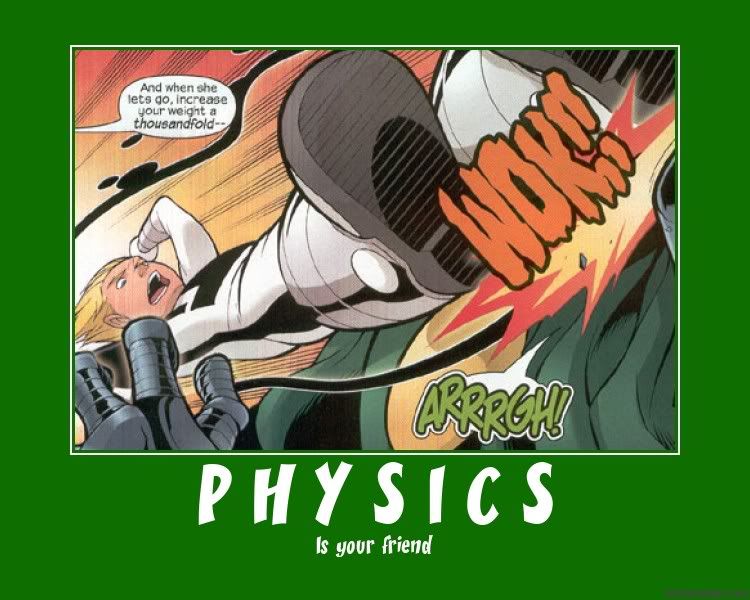Before I go in further, I must give props to Dr. Jim Kakalios, Author of The Physics of Superheroes. This is a great book that goes into a lot of super detail about the science of various superpowers, without being so complex that you need a degree to follow it. Of course, if you have a degree, it makes it that much more fun. here's a sample video
Neat, huh? Now go buy his book!
Tonite, in anticipation of the upcoming Iron Man Movie, we will take a look at how Iron Man's suit allows him to fly...and how, it would probably end up with him driving himself into the ground like a tent peg.
Looks cool, no? I mean, just suit up, take off and leave all your earthly worries behind. Apparently, gravity would have to be one of these worries.
OK, for those of you who don't feel like taking a course in fluid Mechanics or Aerodynamics, here is the short version...when something moves through a fluid (Gases and Liquids are both considered fluids, albeit with vastly different properties) or a fluid moves over and under a surface, a pressure difference is created, and this force is known as Lift, which, as you can imagine, allows things to fly. The lift force is usually a product of the following elements: Surface area to generate lift, speed, and the properties of the object to generate lift. With aircraft,they have a huge surface area dedicated to generating lift, and that's the wings.
Do you see any wings on Iron Man's Armor? No? Oh, well would a humanoid body be able to generate lift? No, the human form is tremendously crap at that, otherwise skydivers wouldn't fall down quite so quickly. What about speed? In theory, but the problem there is that in the time it would take to get to that speed, you probably would have already crashed, unless your take off point was say, a really tall building. The other alternative would be to accelerate to ridiculous speed, and that would probably cause you to black out, and then crash. By the way, a crash of about 400 lbs going at several hundred miles per hour? It ain't going to be pretty, and once you get the can opener to open the armor, the pilot is going to be not much more than really chunky salsa due to the force of impact. Nevermind poor pedestrians and anyone who was on the ground when he impacted. This, by the way, is why you should be glad there aren't a lot of flying cars and jetpacks, because a midair collision would result in a rain of fiery bits that would look like the opening scene in Armageddon (the movie). Most of us can barely handle maneuvering in two dimensions at several dozen mph; adding another axis, gravity, and multiplying the speed will only worsen things.
None of these seem like good ideas. This leaves with an Iron Man who could only fly straight up and then slow his descent down in giant arcs like the Golden Age Superman, which is still sort of cool. Of course, just to keep himself balanced would require some really advanced gyroscopes capable of near instantaneous self-correction, which would be really neat, but hey, Stark's smart, so I can buy that.
Ah, but there is a way he could achieve flight; point a set of repulsors or engines down. This would give him a means of staying aloft the way a Harrier Jet does when it is performing a Vertical Take-off and Landing (VTOL). Of course, the problem here is that, using Newton's Third Law, for every action there must be an equal and opposite reaction. So while he's providing himself at least 400 lbs of upward thrust, that means whatever is below him is being hit with 400 lbs of force. While at high altitude this might be mitigated, I'd hate to be directly below him when he's flying in the city as the force of his repulsors pointing down would turn me into a human accordion, nevermind crushing mailboxes, fire hydrants, pets, and denting vehicles and other property.
So overall, while the armor is nice, it's probably something that you should be glad doesn't exist in this exact form.
But always remember: Just because it's not realistic doesn't mean it's not fun. I don't know about you, but I'm jacked about going to see this movie.
Cheers.



2 comments:
Yo, Michael! It's cool to see another engineering post on your blog, it is something I rarely do myself :p
Anyway, the variable thrust thing in Iron Man's boots (and apparently his gloves [how would that work??!!]) has hella complications. Thrust vectoring like on the F-35 and VTOL engines work because the thrust acts in one direction relative to where you want to go.
So, and this is pretty funny, what happens when Iron Man (and I mean realistically here, to stretch the term "realistic") points his feet in different directions? He'd end up doing pirouettes while flying upwards, which would look rather nice, I guess, but would lead to him constantly making his legs straight and stuck together. The force or thrust generated seems disproportionate to the size of the engine built into the armor, too.
And you are right about the aerodynamics, there is no real "lifting factor" to Iron Man, other than the thrust. He would need something like a retractable set of wings to properly fly, and instead of having multiple thrust vectors, just something like a regular jet engine fixed somewhere on his suit.
But then again, you can do anything in comics, which is why we love them so much. I cannot wait for the movie! Robert Downey Jr rocks, he is Marvel's best response to DC's Christian Bale.. well, Ed Norton and Brandon Routh are pretty respectable too. Hm.
Some great posters.
Post a Comment